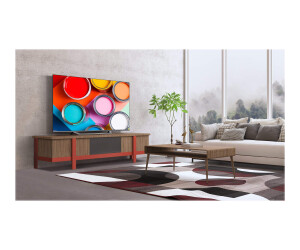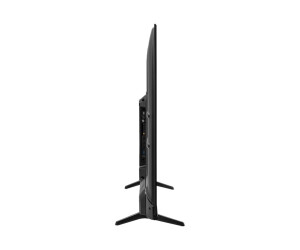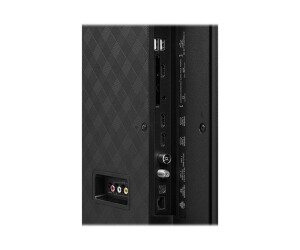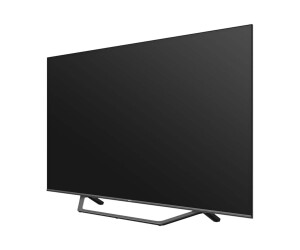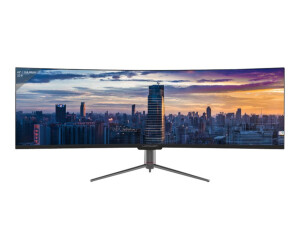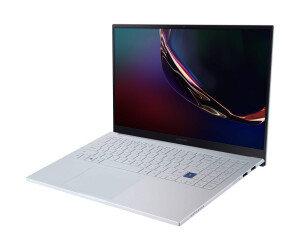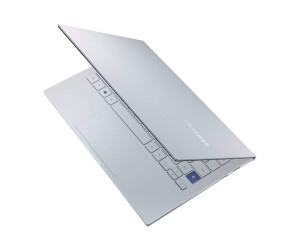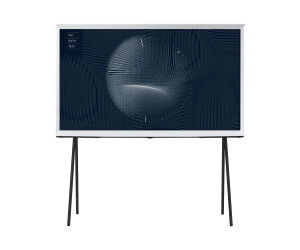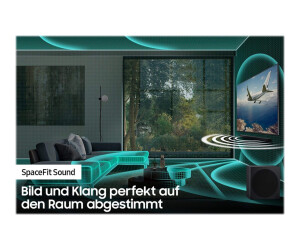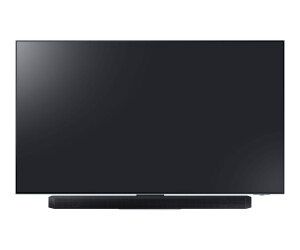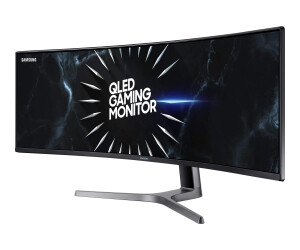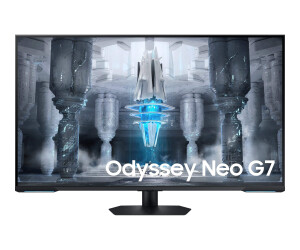QLED
QLED
The abbreviation "QLED" stands for Quantum Dot Light Emitting Diode and represents an innovative technology in the field of Liquid Crystal Displays (LCDs). These panels are known for their exceptional image quality and impressive color representation. Below, I will provide a detailed and comprehensive description of the QLED panel:
Quantum Dots and How They Work:Quantum Dots are fascinating nanoscale semiconductor structures that play a crucial role in the world of display technology. These tiny crystals are made of inorganic materials such as Cadmium Selenide (CdSe) or Indium Phosphide (InP) and are found on the scale of a few nanometers (1 nanometer equals one billionth of a meter).
Their impressive ability to emit light is a direct result of their quantum mechanical properties. When a photon - the smallest measurable particle of light - encounters a Quantum Dot, the electrons in the crystal are excited. This means that the electrons are elevated to higher energy states. Once these electrons return to their original states, energy is released in the form of light. The color of the emitted light depends on the size of the Quantum Dot. Smaller Quantum Dots, for example, emit blue light, while larger Quantum Dots produce red light.
In QLED screens, these Quantum Dots are strategically placed to influence the light source generated by the backlighting. The backlighting is typically a white light source produced by Light Emitting Diodes (LEDs). The Quantum Dots are then used between the light source and the liquid crystals in the display.
The backlighting sends white light through a layer of Quantum Dots. The Quantum Dots absorb a portion of the light while simultaneously emitting new light in specific colors. This process allows the original white light to be transformed into a broader color spectrum. In this way, Quantum Dots significantly contribute to the extended color reproduction and impressive image quality of QLED panels.
It is important to emphasize that compared to organic materials used, for example, in OLED displays, Quantum Dots have higher light output and longer lifespan. This makes them an attractive choice for display technology. However, it should also be noted that the safe handling and disposal of Quantum Dots need to be carefully regulated due to their potential pollutant content.
Color Spectrum and Color Accuracy:The remarkable ability of QLED panels to represent an extended color spectrum is a key feature that distinguishes their outstanding performance in image reproduction. Compared to traditional LCD displays, QLED panels use Quantum Dots to generate an impressively wide range of colors and shades.
Conventional LCD displays typically use fluorescent tubes or LEDs as backlighting. These light sources naturally have a certain range of colors they can emit. However, they are often unable to reproduce the entire color space perceived by the human eye. This means that some colors may appear less saturated or vivid.
QLED panels address this issue by using Quantum Dots. These tiny semiconductor crystals are capable of emitting light in specific wavelength ranges, depending on their size. By selectively integrating Quantum Dots into the panel, manufacturers can influence the light from the backlighting and generate a significantly expanded color spectrum.
The result of this technology is impressive. QLED panels are able to reproduce colors that are closer to the natural colors of the real world. This leads to images that not only appear more vibrant and realistic, but also offer astonishing detail accuracy. The finest nuances in color gradients are clearly depicted, resulting in an immersive visual experience.
The extended color accuracy of QLED panels is also crucial for creative applications. Professional photographers, graphic designers, and video producers appreciate the ability of these displays to accurately and faithfully represent colors. This allows them to be confident that their work is presented in the desired color palette.
It is important to emphasize that extended color reproduction is crucial not only for visual aesthetics, but also for applications in medicine, research, and other industries where precise color reproduction is of great importance.
Brightness and Contrast:The outstanding brightness and impressive contrast are two key aspects that make QLED panels a top choice in display technology. These properties have a crucial impact on visual quality and the panels' ability to provide an impressive viewing experience.
Let's start with brightness: QLED panels are known for achieving exceptionally high levels of brightness. This means that they are capable of emitting an impressive amount of light. This high brightness is crucial in environments with strong ambient light, such as well-lit rooms or outdoor settings. Even under these demanding conditions, QLED displays can deliver clear and sharp images without sacrificing quality. This feature makes them an excellent choice for various applications, from living rooms to public spaces and even outdoors.
High contrast is another impressive feature of QLED panels. Contrast refers to the difference between the brightest and darkest areas of an image. QLED technology allows this difference to be displayed particularly vividly and accurately. This means that bright elements in an image appear more luminous, and dark areas appear deeper. This creates an impressive sense of depth and detail accuracy in image reproduction. This is particularly important for the experience of movies, games, or high-resolution images, where details in both bright and dark areas are equally important.
The high contrast and impressive brightness of QLED panels also contribute to their use in professional applications, such as medical technology or image editing. Here, it is crucial that the finest details are accurately represented, allowing for precise diagnoses or creating creative works at the highest level.
HDR (High Dynamic Range) Support:High Dynamic Range (HDR) support is a significant feature that sets QLED panels apart from conventional displays. It enables an extended representation of the brightness and color range, leading to a significantly improved visual experience.
HDR greatly expands the available brightness range of a screen. This means that both very bright and very dark areas of an image can be displayed with higher precision and detail accuracy. This is crucial for the reproduction of images that contain elements with very different levels of brightness and contrast, such as sunsets, explosions, or strong light reflections.
By enhancing the reproduction of details in bright and dark areas, subtleties and textures can be represented much more accurately. As a result, scenes appear more realistic and vibrant. For example, on an HDR-enabled QLED display, the rays of the sun in a sunset can appear with an impressive radiance, while at the same time, the details in the shadow areas remain precise and sharp.
Another major advantage of HDR is its ability to represent a wider color palette. This makes colors appear more vibrant and natural, which is particularly noticeable in scenes with intense colors or subtle color gradients.
The combination of extended brightness range, improved details, and expanded color spectrum leads to a significantly more impressive visual representation. Movies, games, and other content produced in HDR are particularly impressive on an HDR-enabled QLED panel.
Professional users, such as photographers or video producers, also benefit greatly from HDR support. They can be confident that their content is reproduced with the highest precision and accuracy, which is crucial for their creative processes.
In summary, HDR support is a crucial feature of QLED panels. It significantly expands the brightness and color range, resulting in an impressive visual representation. The improved reproduction of details in bright and dark areas makes the viewing experience even more immersive and realistic. This makes HDR-enabled QLED screens an outstanding choice for demanding visual applications.
Viewing Angle Stability:
The viewing angle stability of a display is a crucial factor for the quality of image reproduction, especially in situations where multiple people are viewing the screen or when the viewing angle can vary. QLED screens excel in this regard.
Compared to some other panel technologies, such as TN (Twisted Nematic) or VA (Vertical Alignment), QLED panels offer remarkable viewing angle stability. This means that colors and image quality remain largely intact even when viewed from side angles or oblique angles. In many conventional displays, colors and contrast can significantly deteriorate when the viewing angle is no longer optimal. This can result in impaired image quality and a diminished visual experience.
The improved viewing angle stability of QLED technology is attributed to the specific way in which Quantum Dots influence light. Quantum Dots ensure that light hits the display more evenly and precisely, regardless of the viewing position. This allows colors and contrasts to be reproduced almost unaltered even from side viewing angles.
This feature is crucial in various applications. For example, in a living room environment where multiple people are watching a movie or series together, good viewing angle stability is essential to ensure that everyone sees a clear and engaging screen content. Also, in professional environments where presentations or creative work is viewed on a screen, stable image quality from different angles is of great importance.
The improved viewing angle stability of QLED technology significantly contributes to maintaining consistent and high-quality image quality and color reproduction, regardless of the viewing position. This is another impressive feature that makes QLED panels a top choice for demanding visual applications.
Energy Efficiency:
The energy efficiency of QLED panels is an extremely significant feature, not only for environmental protection but also for long-term economic benefits. Compared to some other display technologies, QLED screens are particularly resource-efficient.
A central factor in the energy efficiency of QLED panels is how they utilize backlighting. In QLED displays, illumination is provided by Light Emitting Diodes (LEDs), which serve as the light source. These LEDs are known for their high energy efficiency compared to conventional fluorescent tubes or other lighting technologies used in older display models. This means that QLED screens consume less electricity for the same brightness.
In addition, Quantum Dots contribute to energy efficiency. Since they precisely modify the light from the backlighting, they enable more accurate control of color reproduction. This, in turn, leads to more efficient energy consumption by optimizing the illumination intensity in individual color channels.
The lower power consumption of QLED panels also has positive environmental impacts. They reduce carbon dioxide emissions associated with the operation of electronic devices, thereby contributing to environmental conservation. Furthermore, lower energy costs can be a significant financial advantage for end-users.
The energy efficiency of QLED panels is also an important factor in the certification and evaluation of environmentally friendly products. Manufacturers and organizations increasingly value the integration of eco-friendly technologies to offer more sustainable products.
Durability and Reliability:
The durability and reliability of QLED panels are crucial factors that significantly influence their attractiveness for various applications. The technology of Quantum Dots plays a pivotal role in this regard.
An outstanding feature of QLED panels is their remarkable resistance to screen burn-in, also known as "Burn-in." This is a phenomenon where static images are displayed on a screen for extended periods, leading to permanent marking or burning of these images. This can be a problem, especially with OLED displays.
Thanks to Quantum Dot technology, QLED panels are significantly less susceptible to this issue. Quantum Dots themselves are generally very stable and exhibit minimal degradation over time. This means they are less likely to "stick" and are less likely to leave static images on the display.
The improved resistance to burn-in makes QLED screens an excellent choice for applications where static content is displayed over extended periods, such as control rooms for surveillance systems, medical imaging systems, or the gaming world, where user interfaces often contain static elements.
Furthermore, QLED panels are typically very durable and have a long lifespan. This means they continue to provide consistent image quality even after many hours of operation. Compared to some other display technologies that may lose brightness over time, QLED panels maintain their impressive image quality over an extended period.
The high durability and reliability also make QLED screens an excellent choice in high-frequency use environments and demanding operating conditions. They offer reliable performance and minimize downtime, which is particularly important in professional and commercial applications.
Applications:
Due to their impressive image quality and versatility, QLED panels have a wide range of applications, ranging from consumer electronics to professional and specialized industries. Below, some of the most significant applications of QLED panels are described in detail:
Consumer Electronics (Televisions and Monitors):
QLED panels are a leading element in the world of televisions and monitors. With their extended color reproduction, impressive brightness, and high contrast ratios, they provide an outstanding viewing experience for movies, series, video games, and more. Viewing angle stability ensures that content is perceived clearly and sharply from various positions.
Professional Image Editing and Graphic Design:
In professional image editing, the accurate representation of colors and details is crucial. QLED panels are capable of providing exceptionally accurate color reproduction, which is essential for photographers, graphic designers, and video producers. HDR support and high viewing angle stability additionally contribute to the quality of image editing.
Medical Imaging:
In medical imaging, the precise representation of images is of utmost importance for accurate diagnosis. QLED panels offer high-contrast resolution, extended color reproduction, and are well-suited for use in medical environments due to their durability and reliability.
Outdoor Displays:
Due to their impressive brightness and resistance to environmental factors, QLED panels are an excellent choice for outdoor use. They can display clear and visible content even in bright daylight, which is crucial in applications such as digital signage and outdoor advertising.
Advertising and Marketing:
QLED panels are often used in commercial environments to display advertising content and marketing messages with impressive visual quality. The high brightness and extended color reproduction attract the attention of viewers and effectively convey messages.
Aerospace Engineering:
Due to their precision and durability, QLED panels are also used in the aerospace industry. For example, they are used in the cockpits of aircraft or spacecraft where clear and reliable display of information is crucial.Automotive Industry:
In modern vehicles, QLED displays are used for infotainment systems, navigation, and other displays. High brightness and reliability are crucial here to ensure clear visibility even in different lighting conditions.The wide range of applications demonstrates the versatility and high utility of QLED panels in various industries and environments. Their outstanding image quality and technological performance make them one of the leading display technologies on the market.
Local Dimming and Mini-LED Technology:
The combination of Local Dimming and Mini-LED Technology represents a significant advancement in display technology, providing advanced QLED models with an impressive boost in performance.
Local Dimming: Local Dimming is a technology used in QLED displays to enhance contrast and image quality. The backlighting is divided into small zones that can be individually controlled. This means that in dark scenes, the backlighting in the corresponding zones is reduced to achieve deeper blacks and higher contrast.
By precisely controlling the backlighting, QLED panels with Local Dimming can represent the finest details in shadow areas. This is particularly crucial for HDR content, as HDR images often have a significant difference between bright and dark areas. With Local Dimming, QLED displays can reproduce these differences with exceptional precision and impact.
Mini-LED Technology: Mini-LED Technology is another technological advancement implemented in some QLED models. It is an evolution of conventional LED backlighting. Mini-LEDs are smaller and can be arranged in significantly higher density. This allows for the creation of more individual dimming zones, enabling even more precise control of backlighting.
The use of Mini-LEDs contributes to making the Local Dimming technology even more effective. With the higher number of dimming zones, QLED panels with Mini-LED Technology can represent even finer nuances in brightness. This leads to an even more impressive image representation, especially in dark scenes.
Refresh Rate and Response Time:
Refresh rate and response time are two important technical characteristics of QLED panels that significantly contribute to the quality of image reproduction, especially in fast-moving video games or action-packed movie scenes.
Refresh Rate: The refresh rate, measured in Hertz (Hz), indicates how often a screen refreshes the image per second. QLED panels are known for their high refresh rates, often with values of 120 Hz or even 240 Hz. These high refresh rates enable extremely smooth depiction of motion on the screen.
Especially in video games, a high refresh rate is crucial. Fast movements, such as camera rotation or rapid action scenes, are displayed much smoother and more precisely on a QLED panel with a high refresh rate. This can make a significant difference in the gaming experience, as fast reactions are often crucial.
Response Time: The response time of a display refers to the time it takes for a pixel to transition from one state to another. A low response time means that pixels can move quickly from one image to the next, which is particularly important for rapidly moving images.
QLED panels are characterized by their remarkably low response time. This means they are capable of displaying rapidly changing images clearly and sharply. This is especially important in video games, where every millisecond counts. A low response time helps reduce motion blur and deliver a razor-sharp image.
The high refresh rate and low response time of QLED panels contribute to creating an impressive visual experience, especially in applications involving fast motion or action-packed scenes. This makes QLED displays a preferred choice for gamers, movie and sports enthusiasts, as well as anyone with high demands for image quality.
Ambient Light Adaptation:Ambient light adaptation is an advanced feature implemented in some modern QLED screens, making a significant contribution to visual quality under different lighting conditions.
Operation of Ambient Light Adaptation: Ambient light adaptation is based on sensors embedded in the screen that are capable of measuring the ambient light in the environment. These sensors capture the intensity and color temperature of the light falling onto the screen.
Based on these measurements, the QLED screen can automatically make adjustments to brightness and hue. For example, if the ambient light is very strong, the screen can increase the brightness to ensure that the content remains clearly visible despite the strong light. Conversely, in subdued light, the screen can reduce brightness to ease strain on the eyes and save energy.
Advantages of Ambient Light Adaptation:
Optimal Image Quality: Ambient light adaptation ensures that image quality remains consistent in different environments. Whether it's a brightly lit room or a dimly lit space, the screen automatically adjusts to provide the best visual experience.
Comfort and Eye Protection: By adjusting the screen's brightness to the environment, ambient light adaptation helps reduce eye strain. This is especially important during prolonged viewing of screen content.
Energy Efficiency: By automatically adjusting brightness, ambient light adaptation can also contribute to energy savings. The screen only uses as much energy as needed for optimal display.
User-Friendliness: The automatic adjustment means that users do not have to manually fine-tune brightness and hue. This makes using the screen easier and more convenient.
Ambient light adaptation is thus a very useful feature that helps optimize visual quality in different environments. It improves viewing comfort, saves energy, and ensures user-friendly operation of the QLED screen.
Design and Form Factor:
The design and form factor of QLED panels are crucial aspects that influence both the aesthetic integration into the space and functionality.
Sleek and Modern Design: QLED panels are known to typically feature a sleek and modern design. They are characterized by slim bezels and an elegant aesthetic that complements modern room designs. The narrow bezel width directs focus towards the screen content, creating a very appealing and aesthetic overall image.
Diverse Shapes and Sizes: QLED panels are available in a wide range of shapes and sizes to meet various needs and applications. This ranges from slim and stylish televisions for the living room to large monitors for professional applications like image editing, graphic design, or medical imaging. This diversity allows for choosing the appropriate QLED panel for the specific use case.
Mounting Flexibility: Many QLED models also offer high flexibility in mounting. They can be wall-mounted, placed on specialized stands, or integrated into specially designed furniture. This flexibility allows for optimal integration of the QLED panel into the space and optimization of the viewing angle.
Integration into Modern Room Design: Due to their sleek design and modern aesthetics, QLED panels fit well into contemporary room designs. They seamlessly blend into modern living rooms, offices, or other spaces, enhancing the overall look.
High-Quality Materials and Craftsmanship: Most QLED panels are crafted from high-quality materials and offer top-notch workmanship. This not only contributes to visual attractiveness but also ensures long-lasting durability and reliability of the screen.
The design and form factor of QLED panels are a combination of aesthetic appeal and functional flexibility. They offer a wide range of options to meet diverse requirements and room designs, significantly contributing to the optimal integration of the screen into the respective space.
Future Perspectives and Technological Development:
The future perspectives of QLED technology promise an exciting advancement that will further enhance the performance and applications of this screen technology. Some of the most promising developments include:
Improved Quantum Dot Materials: Research and development in the field of Quantum Dot materials are expected to lead to enhanced properties. These include an even wider color reproduction, higher brightness and efficiency, as well as more precise color control. The refinement of Quantum Dot technology will thus result in even more impressive visual experiences.
Advanced Panel Structures: The structure of the panels themselves is expected to be further improved. This could include, for example, the implementation of even finer dimming zones for Local Dimming or the introduction of innovative materials that enhance the panels' performance.
Advancement of HDR Technology: High Dynamic Range (HDR) is a key technology for impressive visual effects. Future developments will likely enable an even wider and more impressive representation of brightness and color spectrums, leading to an even more realistic and immersive image quality.
Integration of AI and Smart Functionalities: With the ongoing development of Artificial Intelligence (AI), future QLED panels may be capable of automatically adapting to user preferences and needs. Smart features could also enable optimized image processing and upscaling techniques to further improve image quality.
Sustainability and Environmental Friendliness: Considering the increasing importance of environmental protection and sustainability, future QLED technologies are expected to become even more energy-efficient. This could be achieved, for example, through the use of resource-efficient materials or improved recycling methods.
Specialized Applications and Industry Solutions: QLED technology is expected to continue being used in specialized applications such as medicine, aerospace, and the automotive industry. Tailored solutions could be developed to meet the specific requirements of these industries.
The future of QLED technology is full of exciting developments and innovations. Improved Quantum Dot materials, advanced panel structures, AI integration, and sustainability efforts will contribute to QLED panels continuing to play a leading role in display technology in the years to come.
Environmental Friendliness and Sustainability:
Environmental friendliness and sustainability are important aspects in today's technology landscape. QLED panels contribute to an eco-friendly approach through several features:
1. Use of Quantum Dots: The use of Quantum Dots, an advanced technology in QLED panels, contributes to environmental friendliness. Quantum Dots are typically free from toxic heavy metals like mercury, which can be present in some other display technologies. This reduces potential environmental risks in the manufacturing, disposal, and operation of the panels.
2. Energy Efficiency: QLED panels are known for their energy efficiency. They require less power compared to some other display technologies. This leads to a reduced environmental impact and lower energy costs. The lower energy consumption contributes to reducing the carbon footprint.
3. Durability and Reliability: The Quantum Dot technology gives QLED panels high resistance to screen burn-in. This means that the panels provide consistent image quality even after many operating hours. This extends the panels' lifespan and reduces the need for replacement purchases, ultimately contributing to a reduction in electronic waste.
4. Recyclability: QLED panels are made from materials that are potentially recyclable. This facilitates the disposal and recycling of non-functional or outdated panels. An effective recycling infrastructure can help further reduce the technology's ecological footprint.
5. Sustainable Production Processes: Manufacturers of QLED panels are increasingly adopting sustainable production practices. This includes the use of renewable energy in production, waste reduction, and the use of eco-friendly materials. These measures help minimize the overall impact of production on the environment.
6. Certifications and Standards: Some QLED panels may receive certifications for environmental standards like Energy Star or other local environmental regulations. These certificates confirm the environmental compatibility and energy efficiency of the products.
QLED panels are an environmentally friendly choice compared to many other display technologies. Their use of Quantum Dots, energy efficiency, durability, and manufacturers' sustainability efforts contribute to minimizing environmental impacts and aligning the technology towards a more sustainable future.
Price-Performance Ratio:
The price-performance ratio of QLED screens is a crucial factor that contributes to their attractiveness for consumers and professional users. Here are some reasons why the price-performance ratio of QLED screens is often highly rated:
1. Image Quality and Technology: QLED screens offer impressive image quality with vibrant colors, high brightness, and strong contrast. The Quantum Dot technology ensures that they excel in terms of color reproduction and detail accuracy. Compared to other technologies, QLED provides an excellent visual experience.
2. Advanced Features: QLED screens are often equipped with a range of advanced features, such as HDR support, Local Dimming, high refresh rates, and low response times. These features are particularly crucial for demanding applications like gaming, image editing, or movie playback.
3. Versatility of Applications: QLED screens are used in a variety of applications, from consumer electronics to professional fields. They are equally well-suited for movies, games, image editing, and more. Their versatile use makes them an attractive option for a wide range of users.
4. Durability and Reliability: Due to the use of Quantum Dots, QLED panels are less susceptible to screen burn-in, extending their lifespan. This contributes to cost-effectiveness, as users need to purchase replacement devices less frequently.
5. Competitive Prices: While QLED technology is among the most advanced on the market, some manufacturers offer competitive prices for their products. This makes QLED screens often more affordable compared to other high-end technologies like OLED.
6. Future-Proof: As QLED technology continues to evolve, there is a high likelihood that future models will be even more powerful and feature-rich. This means that users investing in a QLED screen are acquiring a technology that will remain relevant and competitive in the years to come.
QLED screens offer an impressive price-performance ratio, making them an extremely attractive option for discerning consumers and professional users. The combination of outstanding image quality, advanced features, and an attractive price positions QLED as a technology that holds a strong position in many application areas.
Smart TV Integration and Additional Features:
TV integration and additional features are crucial aspects that make QLED TVs attractive. Here are the various aspects in detail:
1. Smart Operating Systems: QLED TVs are typically equipped with smart operating systems that provide a user-friendly interface. Popular operating systems like Tizen (Samsung), webOS (LG), or Android TV (Sony, Philips) offer intuitive navigation and an easily understandable home screen.
2. Access to Streaming Services and Apps: Through these smart operating systems, users have access to a variety of streaming services like Netflix, Amazon Prime Video, Hulu, Disney+, and many others. Additionally, users can download additional apps through the integrated app store to personalize their entertainment experience.
3. Internet Capability: The integration of Wi-Fi allows seamless connection to the internet. This enables users not only to access streaming services but also to browse the web, use social media, and much more.
4. Voice Control and AI Assistants: Some QLED TVs offer advanced voice control features, allowing users to control the TV using voice commands. Integrated AI assistants like Bixby, Google Assistant, or Amazon Alexa provide additional interaction possibilities.
5. Picture-in-Picture and Multi-Screen Functions: Some QLED TVs offer picture-in-picture functions, allowing users to view two programs simultaneously. This is particularly convenient when users want to follow multiple content streams at the same time. Additionally, some models also offer multi-screen functions, allowing content from different devices to be displayed on the screen.
6. Gaming-Optimized Features: For gaming enthusiasts, some QLED TVs offer special features like a low-latency mode and variable refresh rates, enabling an optimal gaming experience.
7. Image and Sound Enhancement Technologies: In addition to picture quality, QLED TVs often include advanced technologies for improving both image and sound. These may include features like noise reduction, image upscaling, audio optimization, and more.
8. Connectivity and Interfaces: Modern QLED TVs are equipped with a variety of ports and interfaces, including HDMI, USB, Ethernet, and Bluetooth. This allows various external devices like gaming consoles, Blu-ray players, and soundbars to be easily connected.
TV integration offers a variety of additional features in QLED TVs, providing a wide range of entertainment options. From streaming services to smart voice controls and gaming-optimized functions, these extras offer a versatile and interactive TV experience.
Sound Technology and Audio Quality:
Sound technology and audio quality in QLED TVs are crucial factors that significantly influence the overall experience. Here are the various aspects in detail:
1. Advanced Audio Technologies: Some QLED models are equipped with advanced audio technologies that allow for optimized sound reproduction. These include technologies like Dolby Atmos, DTS:X, and other immersive audio formats that provide an impressive 3D surround sound experience.
2. Speaker Systems and Channel Count: QLED TVs feature built-in speaker systems with varying capabilities depending on the model and size. Some models offer multiple speaker channels that enable precise sound reproduction and spatial audio imaging.
3. Sound Optimization and Equalizer: Modern QLED models often include integrated sound optimization features and equalizers. These allow users to adjust the sound to their individual preferences and achieve the best possible audio quality.
4. Clear Voice and Dialogue Enhancement: To ensure that dialogues in movies and TV shows are clearly understandable, some QLED models offer special dialogue enhancement features. This can significantly improve speech intelligibility, especially in environments with background noise.
5. Subwoofer and Bass Enhancement: Some advanced QLED TVs are equipped with an integrated subwoofer or bass enhancement technology. This amplifies the bass range, providing an impressive sound experience, particularly during action-packed scenes or music playback.
6. Wireless Audio Support: Some QLED models support wireless audio standards like Bluetooth, allowing users to easily connect wireless headphones or external speakers.
7. Compatibility with External Audio Devices: QLED TVs typically offer a variety of ports and interfaces for connecting with external audio devices such as soundbars, home theater systems, or AV receivers. This allows users to further optimize their audio experience.
8. Personalized Sound Settings: Some QLED models offer the ability to save individual sound profiles and presets. This allows users to store and retrieve various audio settings for different content or environments.
Thanks to advanced sound technologies and high-quality speaker systems, QLED TVs provide an impressive audio experience. The integration of technologies like Dolby Atmos and the ability to customize sound settings contribute to making QLED TVs convincing not only visually, but also acoustically.
Gaming Optimization:
Gaming optimization in QLED monitors and TVs is a crucial factor that makes them highly attractive to gaming enthusiasts. Here are the various aspects in detail:
1. Low Input Lag: A crucial aspect for an optimal gaming experience is low input lag. QLED monitors and TVs are designed to minimize the delay between pressing a button on the controller and the actual response on the screen. This allows gamers to make fast and precise inputs, which can be crucial in competitive situations.
2. High Refresh Rate: QLED devices often offer a high refresh rate, measured in Hertz (Hz). A higher refresh rate means the screen can display more frames per second, resulting in smoother motion and an overall improved gaming experience. Typically, QLED monitors offer refresh rates of 120 Hz or even 240 Hz, which is particularly advantageous for fast-paced action games.
3. Variable Refresh Rate (VRR) Support: Variable Refresh Rate (VRR) technology synchronizes the monitor's refresh rate with the actual game's frame rate. This prevents tearing (the tearing of images) and ensures smooth display even when the game's frame rate fluctuates. Technologies like AMD FreeSync and NVIDIA G-Sync are examples of VRR implementations.
4. Low Motion Blur and Black Frame Insertion (BFI): Some QLED devices feature functions like Low Motion Blur and Black Frame Insertion. These technologies reduce motion blur and enhance the clarity of quickly moving objects in the game.
5. Gaming Modes and Profiles: QLED monitors and TVs often offer special gaming modes and profiles that adjust the picture and color settings for optimal game display. These modes can also optimize settings like brightness, contrast, and color saturation to enhance the gaming experience.
6. Game Enhancer and Input Signal Plus: Some QLED models have features like Game Enhancer, which optimizes picture quality, and Input Signal Plus, which further reduces input lag.
7. HDR Support for Impressive Visual Effects: HDR support in QLED devices provides impressive visual effects, especially in games that offer HDR content. This enhances the display of details in bright and dark areas.
QLED monitors and TVs offer a wide range of features specifically tailored to the needs of gamers. From low input lag to high refresh rates and VRR support, these features contribute to providing a smooth and impressive gaming experience.
Collaboration with Other Technologies:
The collaboration of QLED panels with other advanced technologies is a crucial aspect that further enhances their versatility and performance. Here are the various aspects in detail:
1. HDMI 2.1 Compatibility: QLED panels are typically equipped with HDMI 2.1, an advanced connection standard that supports higher bandwidth. This enables the transmission of high-resolution 4K and even 8K content with higher frame rates. Additionally, HDMI 2.1 also enables advanced features like Variable Refresh Rate (VRR) and Auto Low Latency Mode (ALLM), which are particularly beneficial for gaming enthusiasts.
2. Dolby Vision and HDR10+ Support: QLED panels are often compatible with advanced HDR formats such as Dolby Vision and HDR10+. These formats provide enhanced dynamic range and color depth, resulting in impressive visual effects. The support for Dolby Vision and HDR10+ allows for an even more detailed representation of bright and dark scenes.
3. High-End Audio Formats: Some QLED models also offer support for high-end audio formats like Dolby Atmos and DTS:X. These provide an immersive 3D surround sound experience that complements the impressive visual display of the panels.
4. Smart Home Integration: Modern QLED panels can often be integrated into a smart home ecosystem. They are compatible with voice assistants like Amazon Alexa, Google Assistant, or Apple HomeKit. This allows users to control their TV using voice commands and integrate it into their smart home.
5. Compatibility with Game Consoles and Multimedia Devices: QLED panels are typically compatible with various game consoles and multimedia devices. They offer a variety of ports including HDMI ports, USB ports, Ethernet, and more to ensure seamless connectivity with external devices.
6. Streaming Services and Apps: QLED panels often provide access to a wide range of streaming services and apps. Collaborating with platforms like Netflix, Amazon Prime Video, Disney+, and others allows users to access a wealth of content.
7. Multi-Device Synchronization: Some QLED models offer the ability to synchronize multiple devices. This allows, for example, mirroring the screen of a smartphone onto the TV or using the TV as a central control hub for various multimedia devices.
QLED panels are typically highly compatible with other advanced technologies. This collaboration enables seamless integration into a diverse ecosystem of devices, providing users with a wide range of features and capabilities.
Advanced Image Processing and Upscaling:
Advanced image processing and upscaling are crucial features of modern QLED models that help optimize image quality and display lower resolution content in impressive quality. The various aspects of these technologies are explained in detail below:
1. Powerful Image Processing Processors: Modern QLED models are equipped with powerful processors specifically designed for image processing and enhancement. These processors analyze the received image in real-time and apply various techniques to optimize image quality.
2. Noise Reduction and Image Sharpness: The image processing processors use advanced algorithms for noise reduction. They reduce distracting image noise, resulting in clearer and sharper images. This is particularly beneficial for lower resolution content or poorly lit scenes.
3. Edge Enhancement and Detail Improvement: Edge enhancement technology analyzes the contours of objects in the image and improves their sharpness and definition. This helps make fine details and textures more visible, which is especially important for high-resolution content.
4. Color Enhancement and Optimization: The image processing processors can optimize color accuracy and saturation to produce more vibrant and realistic colors. This is crucial, especially for displaying HDR content and scenes with varying lighting conditions.
5. Dynamic HDR Adjustment: Some QLED models feature technologies for dynamically adjusting HDR content. This technique optimizes the display of bright and dark areas of an image in real-time to provide an impressive HDR experience.
6. Upscaling of Lower Resolution Content: One of the most impressive features is upscaling lower resolution content. This involves converting lower resolution content (e.g., HD or SD) to the native resolution of the screen. Modern upscaling algorithms can achieve remarkably realistic and detailed results.
7. Motion Enhancement: For fast motion in videos or games, some QLED models offer special motion enhancement technologies. These reduce motion blur and ensure smooth playback.
8. HDR Remastering: Some QLED models feature HDR remastering capabilities that can transform non-HDR content into HDR quality. This allows for improved representation of standard high-definition content.
Modern QLED models offer advanced image processing and upscaling technologies that help optimize image quality and display lower resolution content in impressive quality. These technologies significantly contribute to elevating the viewing experience on QLED panels to a higher level.
Adjustment Options and User Experience:
Adjustment options and user experience with QLED displays play a crucial role in tailoring image quality to individual preferences. Here are the various aspects in detail:
1. Picture Modes and Presets: QLED displays offer a selection of predefined picture modes tailored to various applications and content types. These modes may include "Cinema," "Sports," "Game," or "Dynamic." Each mode has specific settings for contrast, brightness, color intensity, and other parameters.
2. Color Calibration and White Balance: Advanced QLED models allow users to precisely adjust color reproduction and white balance. This is particularly important for professional applications, such as in image editing or medical imaging.
3. Brightness and Contrast Settings: Users can adjust brightness and contrast to ensure the image aligns with individual preferences and the ambient lighting conditions in the room. This is especially important in differently lit environments.
4. Gamma and Black Level Adjustment: Advanced QLED models also offer the ability to adjust gamma and black level. These settings influence the gradations between brightness levels and the representation of deep black tones.
5. Motion Interpolation and Smoothing: Some QLED models offer features for motion interpolation and smoothing, improving motion in videos and movies. This ensures smoother motion, especially in content with fast motion.
6. Sharpness Settings: Users can also adjust sharpness to ensure that details in the images are displayed clearly and distinctly.
7. Picture-in-Picture and Multi-View Mode: Some QLED models also offer features like picture-in-picture and multi-view, allowing multiple contents to be displayed on the screen simultaneously. This enables a customized multitasking experience.
8. User Profiles and Memory Functions: Modern QLED models often offer the ability to create individual user profiles and save settings. This allows different users to save their individual preferences for image quality and retrieve them as needed.
QLED displays offer a wide range of adjustment options that allow users to tailor the image quality to their individual preferences. From color calibration to adjusting brightness and contrast, these features provide a personalized viewing experience and contribute to getting the most out of the display.
Connectivity and Connection Options:
Connectivity and connection options are crucial aspects of QLED devices as they expand versatility and flexibility in usage. The various aspects are explained in detail below:
1. HDMI Ports: QLED devices are typically equipped with multiple HDMI ports. HDMI (High Definition Multimedia Interface) allows for high-quality transmission of audio and video signals. Modern QLED models often come with HDMI 2.1, which enables higher bandwidth and additional features like Variable Refresh Rate (VRR).
2. USB Ports: QLED displays have a variety of USB ports that can be used to connect various external devices. This may include playing media files from USB sticks or connecting peripherals like keyboards and mice.
3. Bluetooth: Some QLED models offer Bluetooth connectivity, allowing users to connect wireless peripherals such as keyboards, mice, headphones, and speakers. This increases flexibility in using the display.
4. Wi-Fi and Ethernet: Most QLED models have built-in Wi-Fi modules, enabling a wireless connection to the internet. This is particularly important for smart TV features, content streaming, and using online applications. Additionally, QLED devices also offer Ethernet ports for a wired internet connection.
5. Audio Output: QLED displays feature various audio output options, including HDMI-ARC (Audio Return Channel), optical audio outputs, and 3.5mm audio jacks. This allows for connection with external audio devices like soundbars or AV receivers.
6. Antenna Connection: For receiving terrestrial television, QLED TVs have an antenna connection that allows for connecting a TV antenna.
7. Additional Ports: Depending on the model, QLED devices may have a variety of additional ports, such as composite and component ports, headphone outputs, RS232 ports for professional installations, and more.
8. Multimedia Streaming: QLED devices often offer features for multimedia streaming, allowing users to share and play content from other devices on the network.
9. Multi-Device Support: Modern QLED models often provide the ability to connect and use multiple devices simultaneously. This allows, for example, mirroring a smartphone while also having a computer connected.
QLED devices offer a wide range of connection options and connectivity features, allowing users to connect various external devices and fully leverage the versatility of the display. This is particularly important for ensuring seamless integration into the home entertainment system.
Warranty and Customer Service:
Warranty and customer service are crucial factors when purchasing a QLED screen to ensure customer satisfaction and efficiently resolve potential issues. The various aspects are explained in detail below:
1. Warranty Period: Reputable manufacturers typically offer generous warranty periods for their QLED models. These can vary depending on the manufacturer and model, but the warranty period is usually at least one year. In some cases, manufacturers may also offer extended warranties for additional protection.
2. Covered Components: The warranty typically covers all internal components of the QLED screen, including the panel, electronics, ports, and controls. It is important to review the warranty terms to ensure that all essential components are covered.
3. Repair or Replacement: In the event of a defect or issue during the warranty period, most manufacturers provide the option for repair or replacement of the device. Depending on the severity of the issue, the faulty part may be replaced, or the entire device may be replaced.
4. Customer Service Contact and Accessibility: Reputable manufacturers provide various contact options for customer service, such as telephone hotlines, email support, and live chat. It is important that customer service is easily accessible to quickly address issues.
5. Technical Support and Troubleshooting Assistance: The manufacturer's technical support should be knowledgeable and able to assist customers in diagnosing and resolving issues. This may include troubleshooting assistance over the phone or online support.
6. Service Partners and Repair Centers: Reputable manufacturers often have a network of authorized service partners and repair centers responsible for servicing QLED devices. These partners should be well-trained and qualified to perform professional repairs or maintenance.
7. Software and Firmware Updates: The ability to receive regular software and firmware updates is another important aspect of customer service. Updates can improve performance, fix bugs, and add new features.
8. Customer Satisfaction Guarantee: Some manufacturers offer a customer satisfaction guarantee, allowing the customer to return the product within a specified period if they are not satisfied.
In summary, a generous warranty and efficient customer service are important quality indicators when selecting a QLED screen. It gives the customer confidence that they will receive good support in case of issues, ensuring long-term enjoyment of their device. It is advisable to review the manufacturer's warranty terms before making a purchase.
Community and Resources:
The community and resources provided by manufacturers are invaluable in helping users maximize the full potential of their QLED screen. Here are the various aspects explained in detail:
1. Online Forums and Communities: Many manufacturers establish online forums and communities where users can exchange their experiences, discuss issues, and receive tips for optimizing their QLED devices. This creates a vibrant platform for knowledge exchange and user support.
2. User Manuals and Guides: Manufacturers typically provide comprehensive user manuals and guides covering all aspects of setting up, operating, and optimizing the QLED screen. These resources offer clear instructions and useful tips.
3. Video Tutorials and Demos: Some manufacturers offer video tutorials and demos that provide visual guidance for specific features and applications of the QLED screen. These videos can be helpful in understanding complex settings and using them to their full potential.
4. FAQs and Knowledge Bases: Manufacturers often provide FAQs (Frequently Asked Questions) and extensive knowledge bases where users can find answers to common questions. These resources offer a quick solution to frequently encountered issues.
5. Software Downloads and Updates: Manufacturers' websites often provide software downloads and updates that allow users to enhance the performance of their QLED screen. These may include firmware updates or drivers for specific features.
6. Customer Reviews and Recommendations: In addition to official resources, customer reviews and recommendations also provide valuable insights into the experiences of other users with the QLED screen. This can be helpful in making a purchase decision and using the device.
7. Online Chat Customer Support: Some manufacturers also offer online chat for customer support, allowing users to communicate directly with a support representative and receive quick assistance.
8. Training and Webinars: In some cases, manufacturers offer training and webinars that provide deeper insights into the features and optimal use of the QLED screen.
Community and resources provided by manufacturers offer valuable support for users to make the most out of their QLED screen. From online forums to user manuals and videos, these resources cover a wide range of needs and enable effective use of the device.
Energy Efficiency and Environmental Awareness:
Energy efficiency and environmental awareness are crucial aspects when selecting a QLED panel. The various aspects are explained in detail below:
1. Low Power Consumption: QLED panels are known for their comparatively low power consumption. Compared to older technologies like plasma displays or conventional LCDs, QLED panels require less power to produce the same image quality. This leads to lower operating costs and an overall reduced environmental impact.
2. Energy Efficiency Standards and Certifications: Many QLED models meet strict energy efficiency standards and can receive certifications like ENERGY STAR. These certifications confirm that the product meets specific energy efficiency requirements, making it more environmentally friendly.
3. Low Heat Emission: Due to efficient energy use, QLED panels generate less heat during operation. This means they require less cooling, which in turn reduces energy consumption and the need for additional ventilation.
4. Environmentally Friendly Materials: QLED panels typically use environmentally friendly materials that are free from harmful chemicals and heavy metals. This reduces environmental risk and helps facilitate the disposal of the device at the end of its lifespan.
5. Durability and Longevity: The use of Quantum Dots in QLED panels results in higher resistance to screen burn-in. This means that QLED panels are less susceptible to long-term damage, especially in applications where static images are displayed for extended periods.
6. Energy-Saving Features: Modern QLED models often feature intelligent energy-saving functions that optimize energy consumption when the device is not in use. This includes features like automatic shut-off, standby mode, and adjusting backlighting to ambient light conditions.
7. Recycling and Disposal: Many manufacturers offer electronics take-back and disposal programs to ensure that old QLED panels are disposed of or recycled in an environmentally friendly manner.
In summary, the energy efficiency and environmental awareness of QLED panels contribute to reducing environmental impact and long-term costs. The use of environmentally friendly materials and the implementation of energy-saving features make QLED panels a sustainable choice for demanding visual applications.
Smart Control and Voice Assistants:
Smart control and voice assistants are groundbreaking features in many QLED devices that revolutionize the user experience. The various aspects are explained in detail below:
1. Smart Control Systems: QLED devices are equipped with advanced smart control systems that allow users to operate various functions of the television or monitor in an intelligent manner. This can be done via a remote control, smartphone, or even through voice control.
2. Voice Assistants: Many QLED models provide support for leading voice assistants like Amazon Alexa, Google Assistant, or Bixby (developed by Samsung). This allows users to control their QLED screen using voice commands. For example, users can change channels, adjust volume, or search for specific content via voice command.
3. Convenience and User-Friendliness: Using voice assistants and smart control systems makes operating the QLED device more convenient and user-friendly. Instead of using the remote control or navigating menus, users can simply speak and execute the desired action.
4. Smart Home Integration: With the support of voice assistants, QLED devices can be seamlessly integrated into a smart home. For example, users can control lighting, thermostats, or other smart devices in the household using the same voice assistant that operates the QLED screen.
5. Personalized Recommendations and Search: Some QLED models leverage the capabilities of voice assistants to provide personalized recommendations for movies, series, or content. Users can also search for specific content simply by asking.
6. Privacy and Security: Manufacturers place great emphasis on privacy and security when implementing voice assistants. Features are often built in to ensure that user privacy is protected.
7. Continuous Advancements: The technology of voice assistants and smart control systems is constantly evolving. Through software updates, additional features can be added, and performance can be improved.
Smart control and voice assistants enable users to interact with their QLED screen in an intuitive and convenient way. These features not only enhance user-friendliness but also allow for integration into a smart home.
Long-Term Stability and Aging Resistance:
Long-term stability and aging resistance are important aspects of QLED technology that underscore its high quality and reliability. The various aspects are explained in detail below:
1. Long-Term Stability of Image Quality: QLED technology is characterized by its exceptional long-term stability. Even after many hours of operation and years of use, the image quality remains nearly unchanged. This means that colors and brightness remain constant over an extended period.
2. Quantum Dots and Their Resilience: The use of Quantum Dots in QLED panels significantly contributes to long-term stability. These tiny semiconductor crystals are extremely stable and do not tend to lose luminance over time. This is a crucial factor for the long-term quality of displayed images.
3. Low Susceptibility to Screen Burn-In: Compared to some other panel technologies, QLED panels are less susceptible to screen burn-in, where static images are displayed for extended periods. This is particularly important in applications where certain elements on the screen remain fixed for long periods, such as in control rooms.
4. Advanced Materials and Manufacturing Processes: Manufacturers use high-quality materials and advanced manufacturing processes to ensure that QLED panels maintain their performance even under long-term usage. This includes components like backlights, panel structures, and electronic circuits.
5. Environmental Conditions and Operating Environment: QLED panels are designed to operate stably and reliably under various environmental conditions. They are typically resistant to temperature and humidity, enabling their use in different application areas.
6. Continuous Quality Control and Testing: Manufacturers subject their QLED panels to rigorous quality control and testing to ensure they meet high standards. This includes stress tests, long-term operation tests, and tests for resistance to environmental influences.
7. Lifespan and Usage Cycle: QLED panels have a long lifespan, often measured in tens of thousands of operational hours. This makes them a reliable choice for long-term use, both in professional and private settings.
QLED technology is known for its impressive long-term stability and aging resistance. The use of Quantum Dots, high-quality materials, and advanced manufacturing processes contribute to QLED panels offering outstanding image quality even after many hours of operation.
Combination with Other Display Technologies:
Combining QLED technology with other display technologies is an innovative approach to merge the strengths of different technologies, creating impressive displays. The various aspects are explained in detail below:
1. QLED and OLED: A combination of QLED and OLED, often referred to as QD-OLED, is an impressive fusion of two advanced display technologies. QLED brings its strengths in terms of brightness, color accuracy, and energy efficiency, while OLED stands for perfect black levels and superior contrasts. This combination results in a display that impresses in almost every aspect.
2. Enhanced Color Reproduction: The Quantum Dot technology of QLED helps display a wide color gamut with high accuracy. Combined with the natural color reproduction of OLED, it creates an image quality capable of rendering realistic and vibrant images.
3. Increased Brightness and Contrast: QLED technology provides impressive brightness, even in well-lit environments. When combined with the contrast performance of OLED, it results in an even more impressive image display with clear details in both dark and bright scenes.
4. Minimization of Burn-In Effects: The combination of QLED and OLED can help minimize burn-in effects. Quantum Dots are known for their resistance to screen burn-in, which is particularly important in applications where static images are displayed for extended periods.
5. Application Areas and Use Cases: The combination of QLED and OLED is particularly suitable for applications where the highest image quality and reliability are crucial. These include professional image editing, medical imaging, high-end consumer electronics, and design applications.
6. Cost and Availability: It is worth noting that the combination of QLED and OLED is typically found in high-end models and may come with a corresponding price. This makes it a preferred choice for demanding applications where the highest image quality is required.
7. Research and Further Development: The combination of QLED and other display technologies is an area that continues to be intensively researched. New innovations and developments promise even better results in terms of image quality and performance.
Combining QLED technology with other display technologies is an exciting field that has the potential to elevate image quality to a new level. By uniting the strengths of different technologies, impressive displays can be created for use in various demanding applications.
Innovative Applications and Industry Solutions:
QLED panels have proven to be pioneering technology and find applications in various industries. Their precise color reproduction, high brightness, and other outstanding features are crucial in these areas. The innovative applications and industry solutions are explained in detail below:
1. Medical Imaging: In medical imaging, precise and accurate representations are of great importance for diagnoses and treatments. QLED panels offer a wide color gamut and high brightness, enabling the display of medical images in the highest quality. They are used in medical monitors for areas such as radiology, surgery, and diagnostic applications.
2. Aerospace: In the aerospace industry, displays are crucial for the navigation, communication, and monitoring of aircraft and spacecraft. The brightness and color accuracy of QLED panels ensure a clear and reliable display of information, even in the most demanding environments.
3. Automotive Industry: QLED panels are used in modern vehicles to operate infotainment systems, head-up displays, and other display elements. The high brightness is important for ensuring clear visibility in varying lighting conditions, while precise color reproduction aids in displaying navigation maps and multimedia content.
4. Corporate Environments and Conference Rooms: In businesses, QLED monitors are used for presentations, video conferences, and general office applications. The high brightness ensures that content is visible even in daylight, while precise color reproduction is beneficial for professional image and video editing.
5. Control Rooms and Surveillance Systems: In control rooms and surveillance systems used in security and monitoring applications, reliable screens are crucial. The high brightness, viewing angle stability, and resistance to burn-in make QLED panels an ideal choice.
6. Educational Institutions: In schools and universities, QLED panels are used in classrooms and lecture halls to display teaching materials and presentations in high quality. Precise color reproduction is important for providing visually appealing learning content.
7. Gaming and Entertainment: QLED panels offer an outstanding visual experience for gamers and entertainment enthusiasts. The high refresh rate and low input lag ensure smooth gameplay experiences, while the impressive image quality provides an immersive entertainment experience.
QLED panels find wide application in various industries due to their impressive image quality and reliability. From
Advantages and Disadvantages of QLED Panels:
Advantages of QLED Panels:
Impressive Image Quality: QLED panels offer outstanding image quality with vibrant colors, sharp contrasts, and impressive brightness. The Quantum Dot technology enables precise color reproduction.
Wide Color Gamut: Thanks to the Quantum Dot technology, QLED panels can display an exceptionally wide range of colors. This makes images appear more vibrant, realistic, and detailed.
High Brightness and Contrast: QLED panels are known for their impressive brightness. They are capable of delivering clear and sharp images even in brightly lit environments. Additionally, they enable high contrast between bright and dark areas.
HDR Support: QLED screens are typically equipped with excellent HDR support. This enhances the rendering of details in both bright and dark areas, leading to impressive visual effects.
Viewing Angle Stability: Compared to some other panel technologies, QLED screens offer excellent viewing angle stability. Colors and image quality remain largely intact even from side or angled perspectives.
Energy Efficiency: QLED panels are known for their energy efficiency. They require less power compared to some other display technologies, resulting in reduced environmental impact and lower energy costs.
Durability and Reliability: The use of Quantum Dots gives QLED panels high resistance to screen burn-in. This makes them an excellent choice for applications where static images are displayed for extended periods.
Versatile Applications: QLED panels find application in various industries, from consumer electronics to medicine and aerospace. Their precise color reproduction and brightness are crucial in these areas.
Disadvantages of QLED Panels:
Limited Black Levels: Compared to OLED technology, QLED panels cannot achieve the same absolute black levels. This may be noticeable in dark environments.
Potential Bleeding and Clouding: Some models may experience "bleeding," where unwanted light escapes from adjacent pixels. Similarly, "clouding" can occur, causing uneven brightness on the screen.
Costlier than Some Other Technologies: QLED technology is advanced and may therefore be slightly more expensive than some other screen technologies.
Limited Viewing Angles in Some Models: While viewing angle stability is generally good, some models may experience color distortions when viewed from very steep angles.
Potentially More Complex Technology: Due to the complex structure and the use of Quantum Dots, QLED panels may be more prone to repairs compared to some other display technologies.
Conclusion:
In summary, QLED panels, due to their Quantum Dot technology, are among the leading technologies in the LCD screen industry. They stand out for their impressive color reproduction, brightness, and contrast, leading to an outstanding visual experience. This makes them the optimal choice for demanding applications where image quality is crucial. With continuous development, QLED panels will continue to play a significant role in display technology, both in the consumer electronics sector and in professional applications and other industries. Their impressive image quality, energy efficiency, and versatility make them an outstanding option for visual applications of all kinds.


